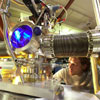Stanford Synchrotron Radiation Lightsource
Novel Coronavirus (COVID-19)
SSRL beam line computer network outage 12/23/2020 8 AM -12 NOON. Remote and local access for beam line PC's and experimental systems will be unavailable during this time.
When we resume operations in January, we anticipate that there will continue to be limits on people allowed onsite due to COVID-19. User experiments will be performed primarily by beam line staff through mail-in samples or remote access. Contact the User Office if you have questions about how COVID-19 impacts your experiments or to request a proposal extension.
In support of COVID-19 related research
Several SSRL beam lines are available to support COVID-19 related work through Rapid Access proposals.
The Stanford-SLAC Cryo-EM research facilities are also operational for COVID-19 related research, see Stanford-SLAC Cryo-EM Center (S2C2) and National Center for Macromolecular Imaging (NCMI).
Department of Energy Basic Energy Sciences light sources want to ensure they are doing everything possible to enable research into this virus and the search for an effective vaccine or other treatment. The DOE supports research into structural biology in partnership with the National Institutes of Health, and other partners. This portal collects relevant structural biology resources in a single location, listing their basic characteristics and a point of contact for each (link is external).
Supporting the User Community
Our Experimental Facilities
Users conduct experiments at SSRL's approximately 30 experimental stations, which utilize extremely bright x-rays produced by the SPEAR3 storage ring. SSRL provides access to beam lines, instrumentation, ancillary equipment supported by dedicated staff scientists and technicians.










